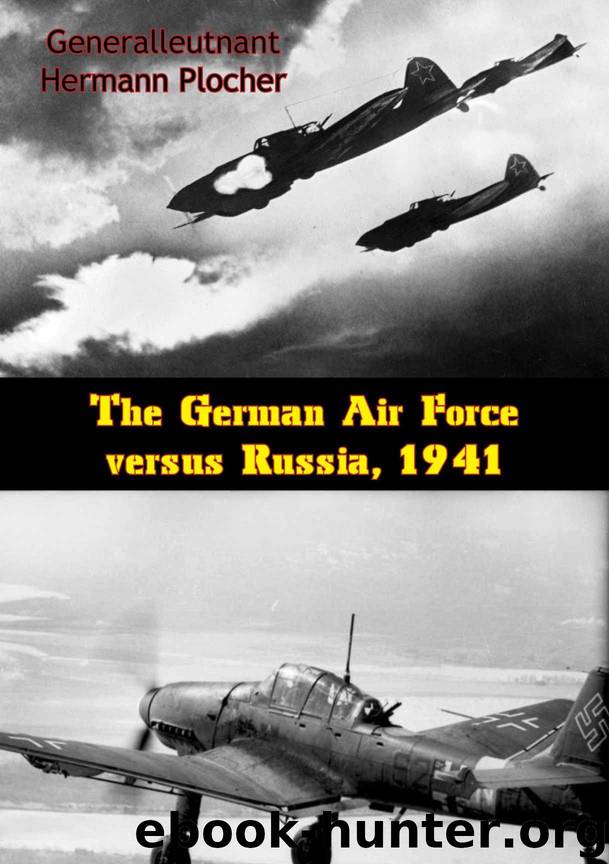The German Air Force versus Russia, 1941 by Generalleutnant Hermann Plocher

Author:Generalleutnant Hermann Plocher [Plocher, Generalleutnant Hermann]
Language: eng
Format: azw3
Publisher: Eschenburg Press
Published: 2017-06-28T04:00:00+00:00
Luftwaffe Participation in Operations BEOWULF I&II
Planning
The capture of Tallinn (Reval) on 28 August and the winning of the western coast of Estonia by German ground forces prepared the ground work for the seizure of the Baltic islands of Muhu, Saaremaa, and Hiiumaa by an attack from the mainland. Responsibility for the execution of this undertaking (Operation BEOWULF) was entrusted to the commanding general of the XXXXII Army Corps, comprising the 217th and 61st Infantry Divisions, to which elements of the Navy and Luftwaffe were assigned. Thus BEOWULF was a joint operation of all the armed forces under one commander.
To seize the islands, two plans, initially involving only the islands of Muhu and Saaremaa, were considered. At the end of June 1941 Army Group North decided in favor of Plan BEOWULF II, which provided for troops operating from the west coast of Estonia, with assembly area at Virtsu, to cross the large strait between the mainland and Muhu and take the islands by an attack from the east.
The reasons for the decision by Army Group North in favor of BEOWULF II over BEOWULF I (which provided for troops operating from northern Kurland, with assembly areas at Roja and Ventspils, to land on Saaremaa in Fettel Bay{326} and at Salme and take the islands from the south and south-west) were:
(1) There was no need for a rapid seizure of the islands, since the Soviet forces there could not seriously interfere with operations on the mainland or with supplies by sea. It was also believed that the Soviet airfields on the islands could be eliminated by counter-air action.
(2) The passage across the relatively narrow large strait promised to be shorter and therefore safer than a crossing from Kurland. Furthermore, the danger of flanking operations by Soviet naval units was considerably less in the large strait.
(3) The landing on the east side of the islands was expected to be easier, since most of the fortifications were situated on the south-western and western sides and were especially designed for defense against attacks by sea, such as the amphibious operation of the German Army and Navy against Saaremaa during World War I.{327}
The Terrain and the Enemy
On the whole the terrain on the Baltic islands is level. A few dunes, most of them covered with coniferous trees, range in height from 160 feet to 223 feet. In 1941 only a small part of the islands was cultivated; the remainder was wasteland, heather, and swampy terrain with pasture land and scrub forests. Stone walls served as boundaries for farm lands, and there were numerous dolmens on Muhu Island, but owing to danger from rock slides, neither the walls nor the dolmens provided good cover. Muhu was connected with Saaremaa by an embankment about 2 ½ miles long. The fog which prevails in the Baltic except during the summer months could severely hamper the progress of the operations.
The total strength of the Soviet forces stationed on the Baltic islands was estimated at 20,000. It was assumed that some 10,000
Download
This site does not store any files on its server. We only index and link to content provided by other sites. Please contact the content providers to delete copyright contents if any and email us, we'll remove relevant links or contents immediately.
| Africa | Americas |
| Arctic & Antarctica | Asia |
| Australia & Oceania | Europe |
| Middle East | Russia |
| United States | World |
| Ancient Civilizations | Military |
| Historical Study & Educational Resources |
Red Famine: Stalin's War on Ukraine by Anne Applebaum(2816)
Chernobyl by Serhii Plokhy(2439)
Midnight in Chernobyl by Adam Higginbotham(2391)
The House of Government by Slezkine Yuri(2105)
Midnight in Chernobyl: The Untold Story of the World's Greatest Nuclear Disaster by Adam Higginbotham(2079)
Red Shambhala by Andrei Znamenski(2072)
The Gulag Archipelago (Vintage Classics) by Aleksandr Solzhenitsyn(1986)
All the Kremlin's Men by Mikhail Zygar(1962)
From Cold War to Hot Peace by Michael McFaul(1940)
Red Notice by Bill Browder(1929)
Putin's Labyrinth(1902)
The Future Is History by Masha Gessen(1822)
From Russia with Lunch by David Smiedt(1797)
A People's Tragedy by Orlando Figes(1768)
The Romanovs by Simon Sebag Montefiore(1723)
How to Tame a Fox (and Build a Dog): Visionary Scientists and a Siberian Tale of Jump-Started Evolution by Lee Alan Dugatkin & Lyudmila Trut(1680)
Putin's Labyrinth: Spies, Murder, and the Dark Heart of the New Russia(1664)
The Lost Spy by Andrew Meier(1634)
Art and Revolution by John Berger(1607)
